Revell


Dassault Rafale models in 1/72 scale

Photo made by me at an air show of a colourful Rafale -C

The Dassault Rafale was designed by Dassault in the 1980/1990s. The design features a canard and delta wing with two SNECMA M88 engines enabling a MACH 1.8 speed at altitude but also supercruise at lower altitudes. It has a multirole capability including that of air superiority fighter. As with many modern combat aircraft, the costs were much higher and it took longer to get an operational capable aircraft. It was introduced in 2001 in the French air force "Armée de l'Air".
Several versions have been developed: the Rafale C single-seater, the -B two seater that is also multirole and the Rafale M for use from the French aircraft carrier(s). The -M has a longer nose strut with larger nose wheels, a stronger structure, a strengthened landing gear and special arrestor hook. It also has a retractable entry ladder.
Various armaments can be carried and fired like MICA, Magic and Apache missiles and it carries and extensive ECM protection and targeting pods can be fitted, like the Thales Damocles and Talios pods. Most Rafales also feature an in-flight tank boom on the nose.
The Rafale was also sold to Egypt, India, Qatar and Greece.

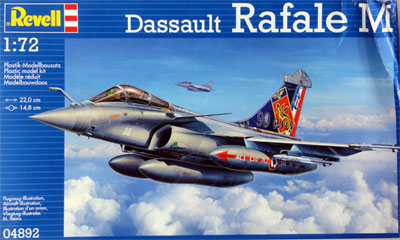
The Revell kit #04892 is nicely done and has 2 plastic sprues in grey and a clear sprue with about 70 parts.
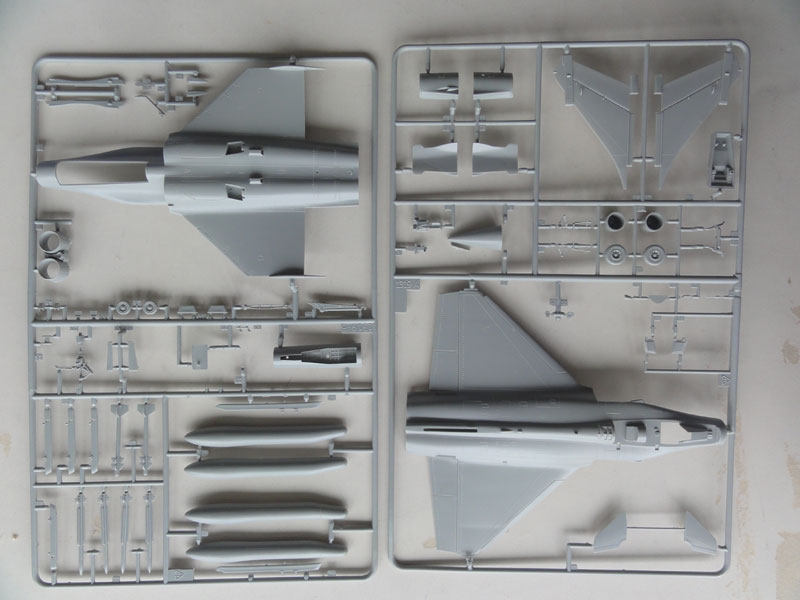
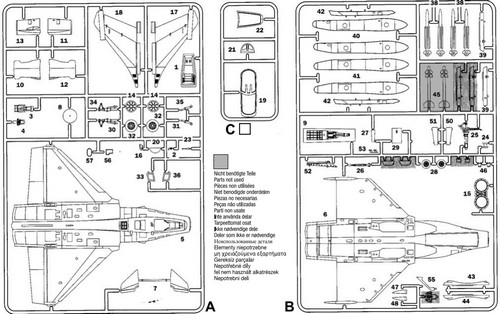

The instructions are fine with detail colours indicated, such as dark grey cockpit interior with black details such as the instrument coaming, medium grey wheel bays and aluminium gear.
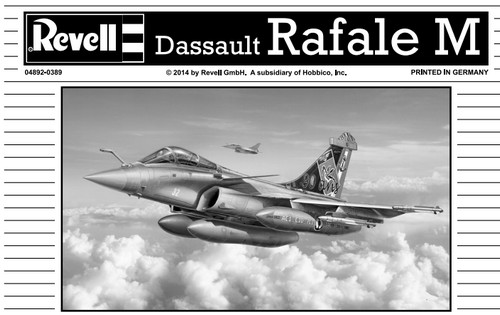
Kit decals are nice for 2 French Aeronavale schemes of 11/12 Flotille with "anniversary tail" and one for Flotille 12F in overall grey.
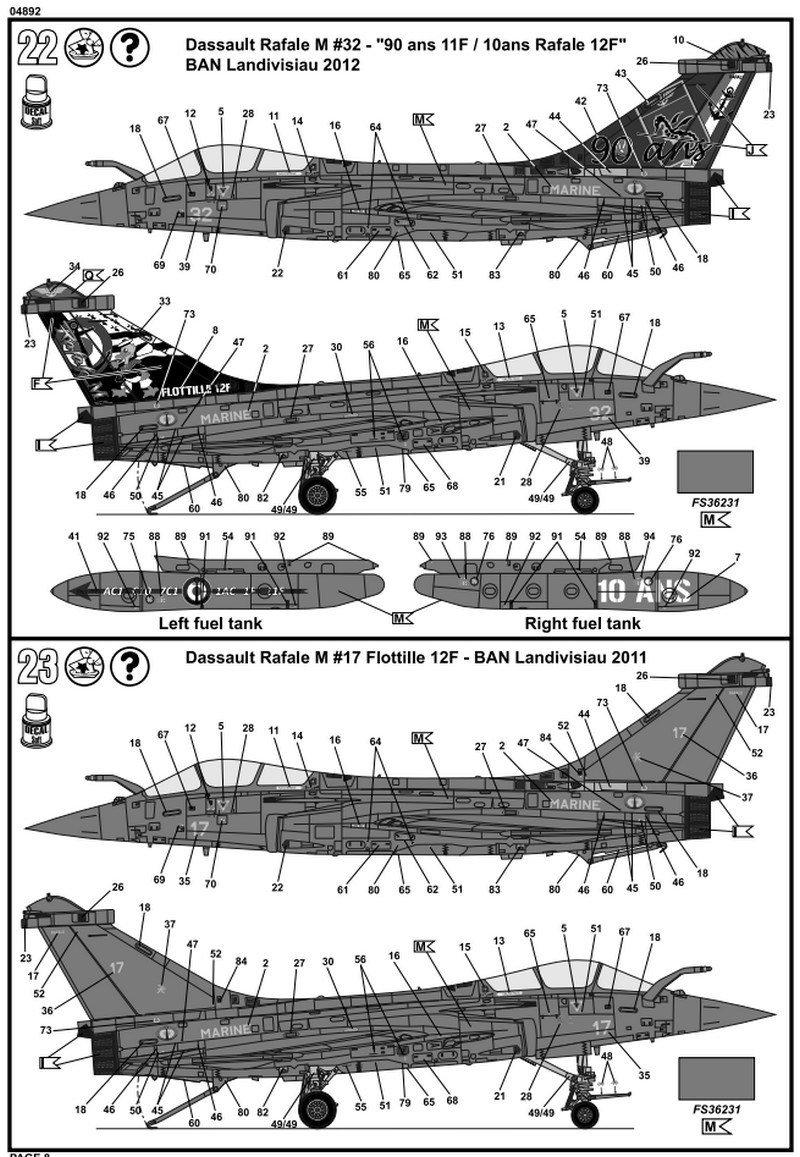
You also get loads of smaller stencils and these are separately indicated on a drawing.
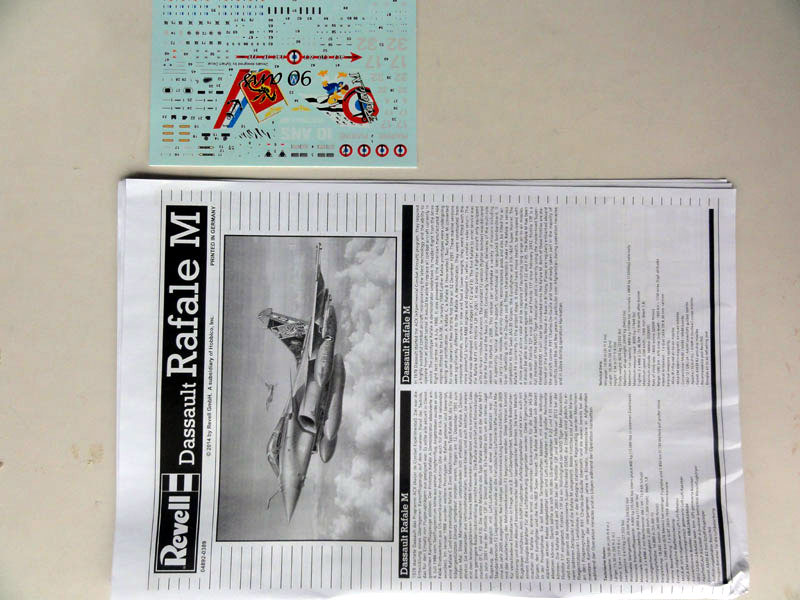
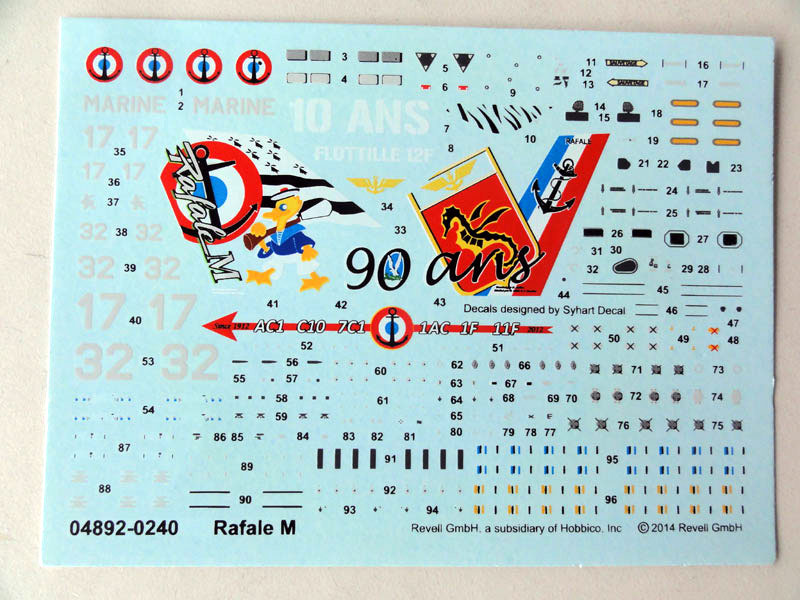
The kit provides as stores 2 under 2000 Liters wing fuel tanks, 4 MICA air-to-air missiles and 2 rather old first generation Magic air-to-air missiles with all pylons. (the Magics are better replaced if you want to install this missile type).
The Revell kit panel lines are not inscribed but raised. Enscribing these is a lot of work, so I did not bother to do this.
I had two Revell kits and as this kit represents a later operational Rafale with the chaff/flare recesses, more details and nice undercarriage than the other older kits, it was decided to make:
[A] the Rafale -M Naval rather straight out of the box;
[B] the second kit a CONVERSION for a land based Rafale -C.
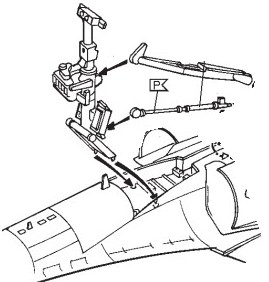
Kit assembly is rather straight forward. I opened up the forward main gear bays "walls" with an X-acto knife.
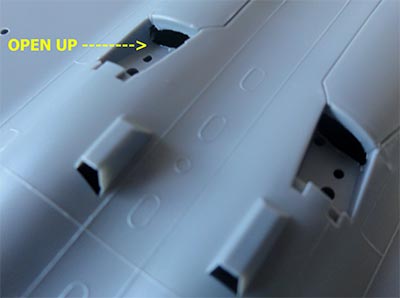
The DEFA 791B 30 mm canon hole beneath the starboard wing root was also drilled open.
Fit the jet exhausts later on and airbrush these metallic jet exhaust silver with Vallejo.
Set the canards only very sligthly 2 degree tilted up (dihedral) after main assembly and the wing has only very slightly 2 degree down angle (anhedral).
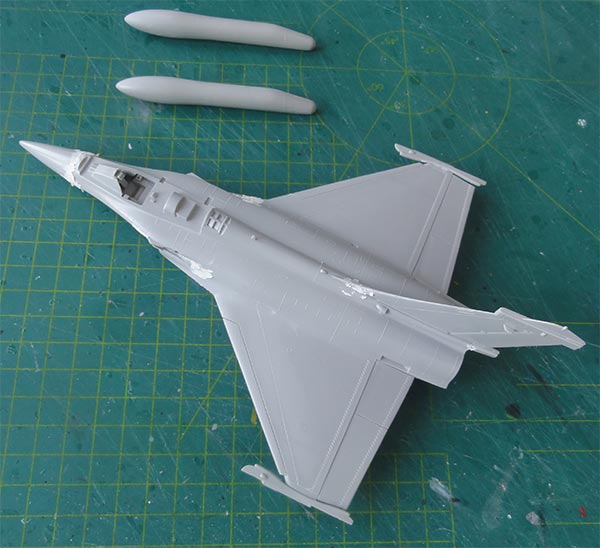
Only small amounts of putty and sanding needed at the intake joints, tail fin joints and radar nose. The fuel tanks only need sanding.
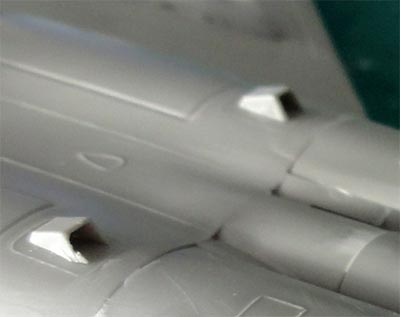
The landing gear can be easily painted after airbrushing and was installed already at the main assembly stage. The main struts slightly are at an angle. Note the launch bar at the -M nose strut and the UHF antenna.
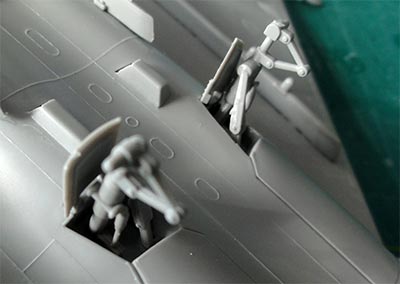 ..
..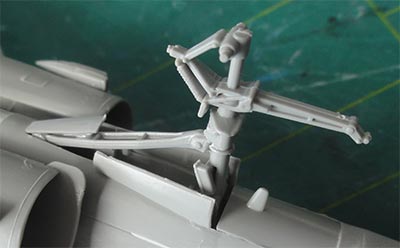
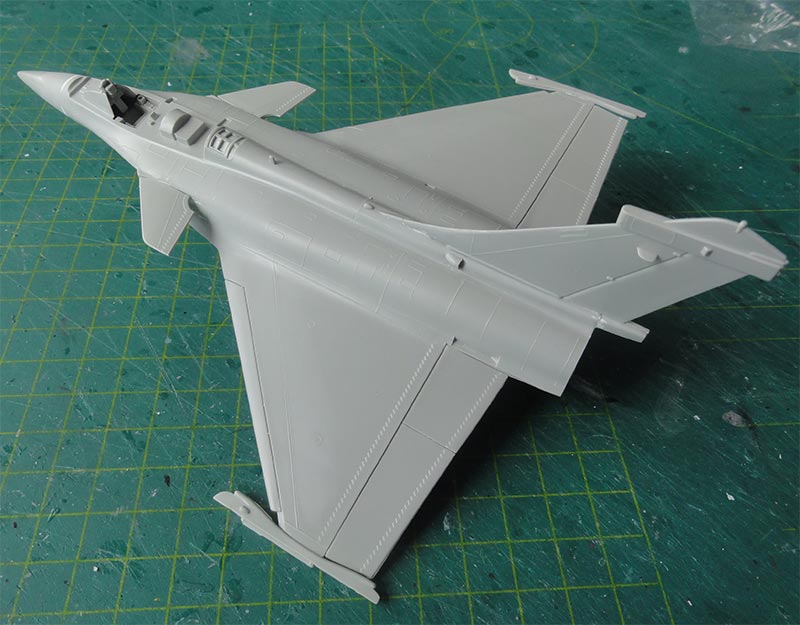
Finally Revell suggests to install the nose pitot but on many modern Rafales this is not fitted anymore. Simply set in place, cut off the tube and sand in a pointy shape.
The French Aeronavale Rafale -M scheme choosen in from the Revell kit for the 90 anniversary scheme with nice tail markings.

For the colour Revell suggest Federal standard FS36231 though I am not sure this is correct, I think the hue was a bit darker. So airbrushed was a mix of 50% Gunze Sangyo H317 of FS36231 + 50% Gunze Sangyo H305 of FS36118 acrylics.
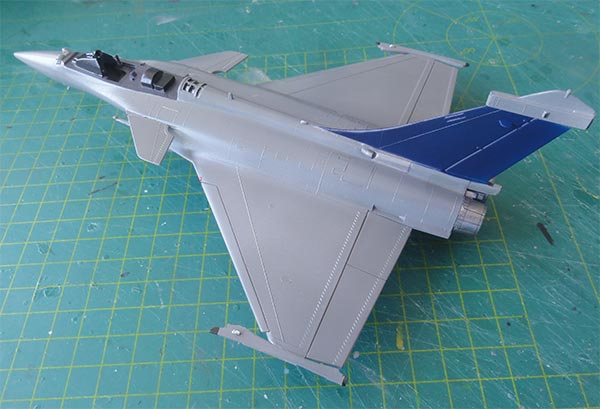
When done, the colourful tail decals need a black right side on the vertical fin and blue left side.
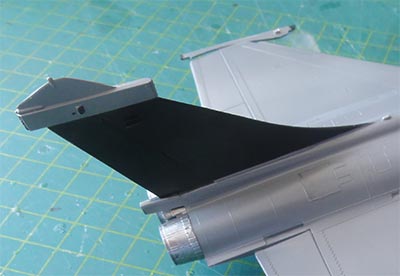
The indicated colours were after masking airbrushed with gloss black and "lufthansa blau" Revell Aqua 350 acrylic respectively.
Detail painting was now done, including the lighter grey insides of gear doors and the undercarriage struts and wheel hubs aluminium. The area aft of the APU exhaust part #A16 was painted metal. The smaller flat areas on the canard fairings for the SPECTRA system were painted darker grey. The -M carrier arrestor hook was painted aluminium.
Once airbrushed, the model got a gloss varnish coat with the usual technique with Johnson Future/ Pledge to avoid decal "silvering". Next, was applying the very nice Revell decals designed by Syhart as per kit for the "anniversary" scheme.

The right tail decal #33 needs a small slot to accommodate the antenna and it is better to cut each large tail decal in two for a better fit. The very tiny light grey decal "dots" were not applied with each decal but with a tootpick dipped in light grey paint.
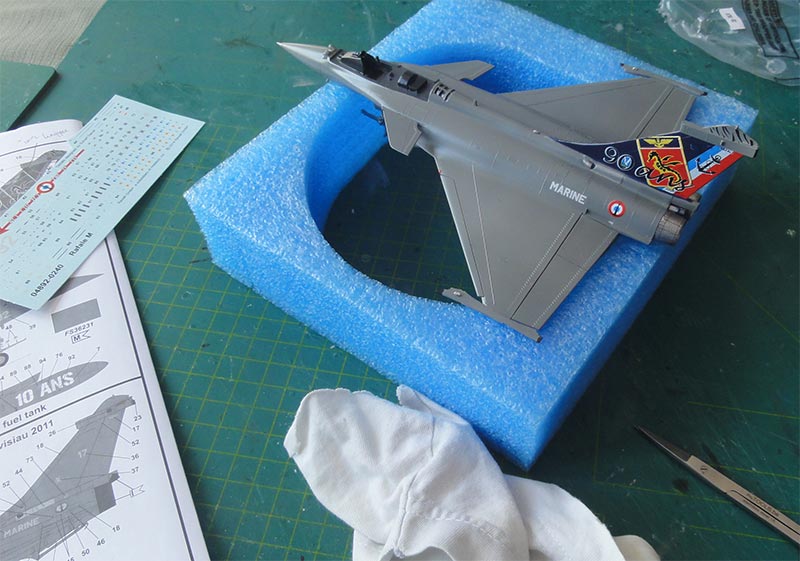
When done, the smaller details were now handled such as the various smaller antennas. The moulded antenna on top of the fin is correct and for the carrier landing system and the 2 side VOR antennas in front of the rudder are correct. The large ECM and RWR tail fairing is also nicely done and also has the small rear position tail light. But the very tiny raised panels on the curved nose side are missing; these were made from a piece of card op 0,5 x 0,5mm.
Detail painting was now done, such as the lighter grey insides of gear doors and the undercarriage struts and wheel hubs aluminium. The area aft of the APU exhaust part #A16 was painted metal and the smaller vertical black cooler grills seen in that area suggested with a very tiny permanent marker.

The smaller flat areas on the canard fairings for the SPECTRA system painted darker grey like the small added nose panels.
But the 2x2 air flow vanes on the lower nose are missing; these were made of thin card.
The license made Martin Baker Mk.16 SEMMB seat part #A3 got some straps and the cockpit a few details added like a "wide angle" HUD made from clear plastic sheet.
A pair of MICA missiles painted white (on many other Rafales these are ghost grey) were added and the 2 fuel tanks.
Finally the model got a gloss varnish coat using a mix of Johnson Future / Pledge floor care thinned with 30% IPA alkohol.
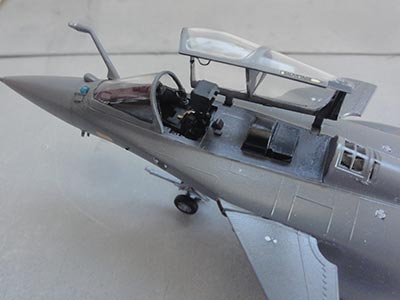
The wind shield and canopy was set in place and that completed this nice Aeronavale Rafale -M model.
FRANCE
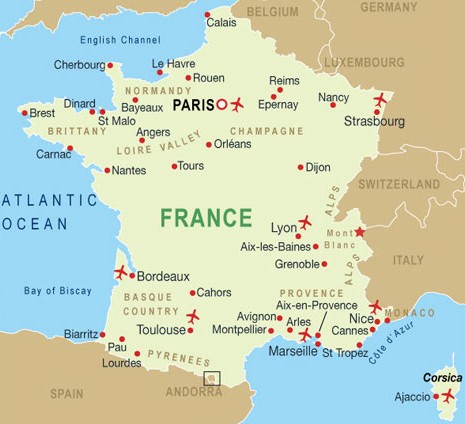

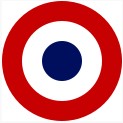
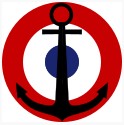
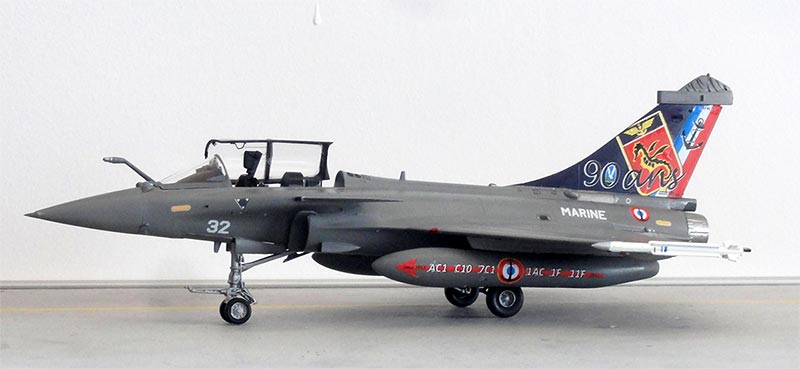
..
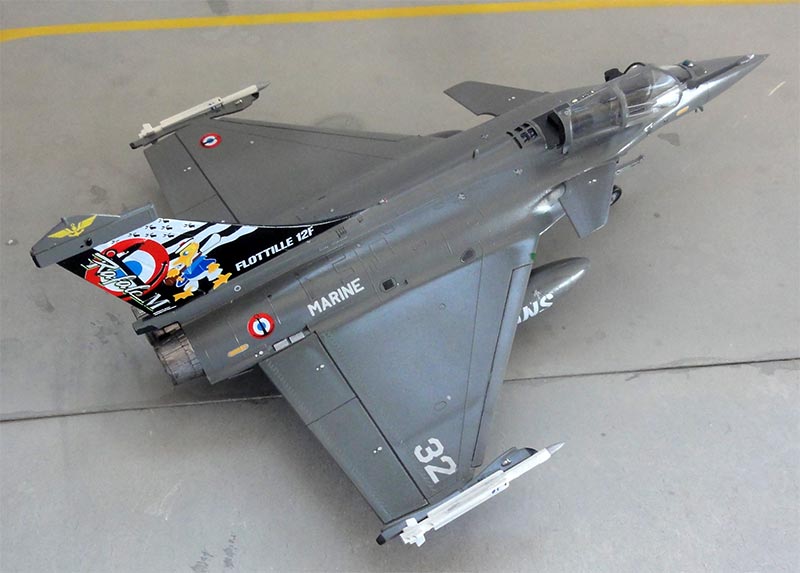

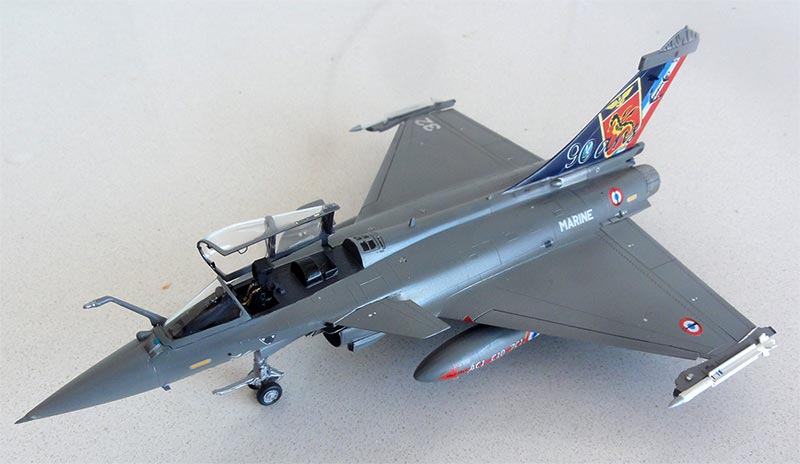
... at Landiviseau
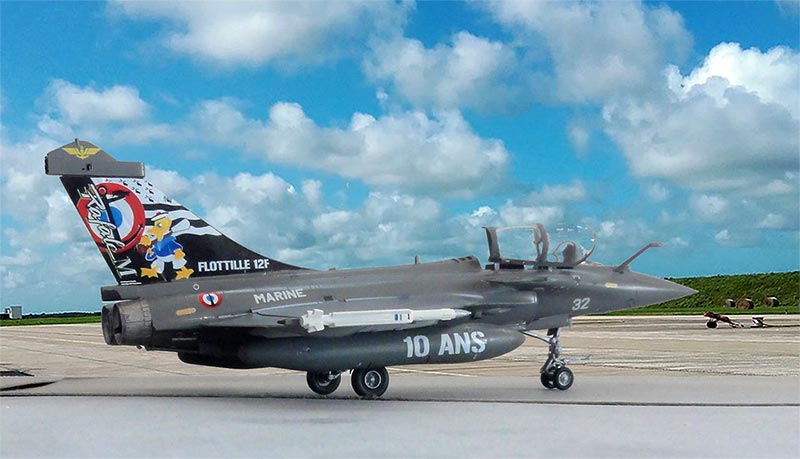
The model will be finished in a QATAR Air Force scheme as Rafale EQ which is the Qatari Rafale -C. A later batch was the Rafale -C EQ F3 version.
How was this conversion done? This will be explained following the Revell instructions steps.
STEPs 1-3 deals with the cockpit and this was made as per kit (but done after main decal work was complete);
In STEP 4 it was decided not to drill open the holes for the rear fuselage pylons;
In STEP 5 the fuselage can be closed as per kit.
The landing gear will be set gear down. The -M nose gear needs to be modified for the Rafale -C as it has the standard short nose strut and also smaller wheels. This was changed looking at the Italeri -C kit:
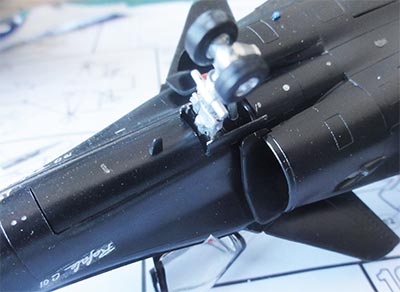
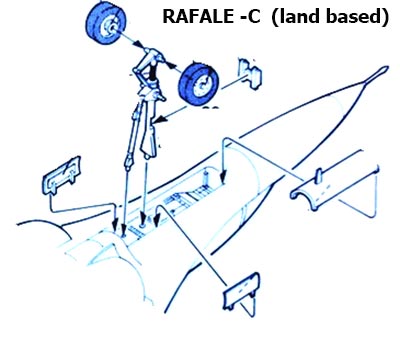
In STEP 6 the part #B9 of the bay was adapted: forward door part #B29 was set closed as was the rear door #B27.

The new -C bay puttied and all sanded smooth and forward doors inscribed.
 ..
..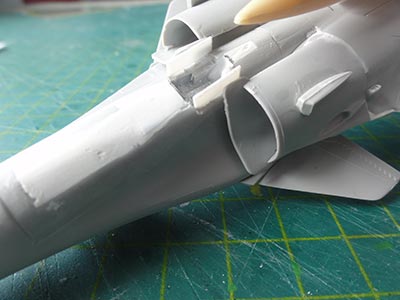
As the gear will be set down, 2 small gear doors were needed and made from card to be installed next to the nose gear strut.
The Revell -M kit nose wheels are 7,5 mm in diameter whereas the nose wheels of the -C are 5,5 mm in diameter; again I simply checked with the older Italeri kit and photos. New smaller -C nose wheels of 5,5 mm were found in the spares box.
STEPs 7,8,9
I did not fit the small scoops #B46 but the rest was made as per kit including parts #B47 and B48 for the SPECTRA ECM fairings. The jet exhausts are better installed after airbrushing and separate jet exhausts airbrushed metallic jet exhaust silver with Vallejo.
STEPs 10,11
The Revell kit -M nose gear strut was modified and made about 5 mm shorter for the -C. Part #B24 was moved to the front of the strut. Do not use #B26 but make a new retraction bar.
STEPs 12,13
The main undercarriage was made as per kit. Though the kit parts for the -M are supposed to be the heavier stronger struts, for this scale it was decided the changes are almost invisible. I could not see a difference in the wheels between the -M and -C in diameter, so the kit wheels were also used.
STEP 14
I did not fit the rear fuselage missile pylons. The tail hook and fairing of the -C has another shape (for land based arrestor hook landings), so part #B52 was not used. The EQ also has this. From scrap plastic a small fairing and hook were made looking at the Italeri -C kit.
STEPs 15-19
These deal with stores like 2000 L fuel tanks, missiles and cockpit canopy and so on can be made as desired. Similar per kit as standard for single seater Rafales.
STEP 20
The small Infrared tracker and passive visual light fairings in front of the windscreen may vary between specifice Rafales. The refuelling probe is seen on most Rafales. For the Qatar Rafale -C EQ the parts as per kit were used. The EQ does however not feature a pitot tube. So pitot part #A23 was seen, cut and sanded in shape to get a pointy radar nose.
I also opted to add a central pointy 1250 Liters fuel tank about 80 mm long with a scrap pylon. The tank was found in the spares box and set in place.

Main assembly was now done.
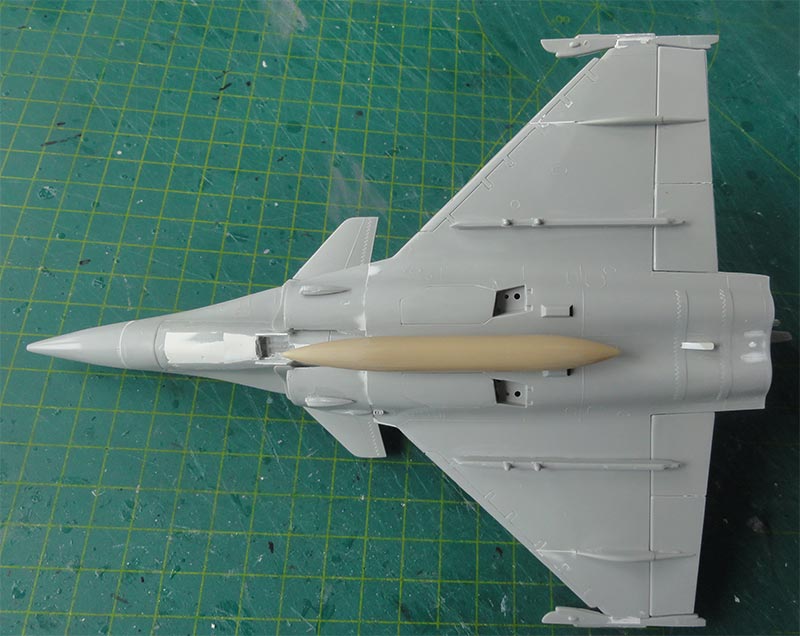
The Qatar EQ Rafales have a specific gray camouflage. First the lighter colour was airbrushed, of ghost gray FS36320 with Gunze Sangyo H307 acrylic. Masking was done with some Revell masking foil to get pretty hard demarcations.
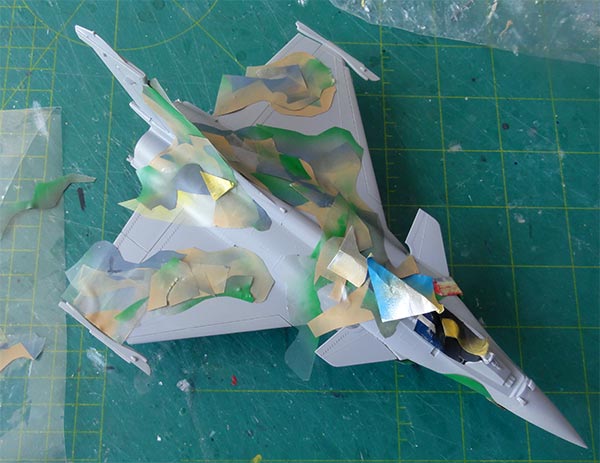
For the darker camouflage pattern including the lower surfaces darker gray FS36152:
For this colour I did not have a paint at home, so airbrushed was a mix of 50% Gunze Sangyo H317 of FS36231 + 50% Gunze Sangyo H305 for FS36118 acrylics.
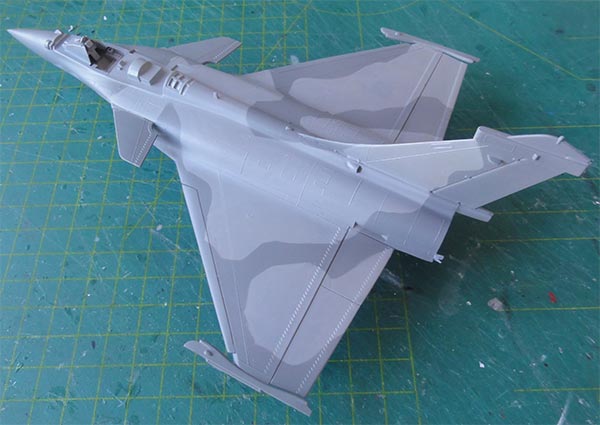
A view of the nose gear....
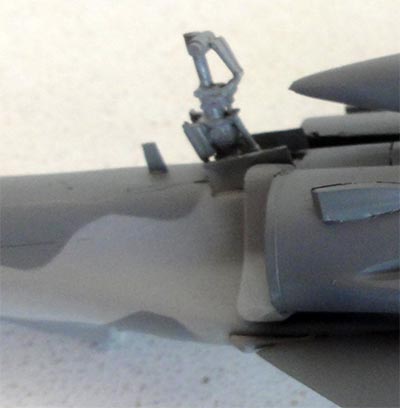
Once airbrushed, the model got a gloss varnish coat with the usual technique with Johnson Future/ Pledge to avoid decal "silvering".
Next, was applying the Qatar scheme. The Qatar roundels and QA codes came from a Berna decals BD-72-72 Mirage 2000 decalset and all was set. The code was applied with separate number decals from an Xtradecal set. The flags on the tail were made from decal bits of red and white. The "horse" symbol was drawn with a permanent black marker.
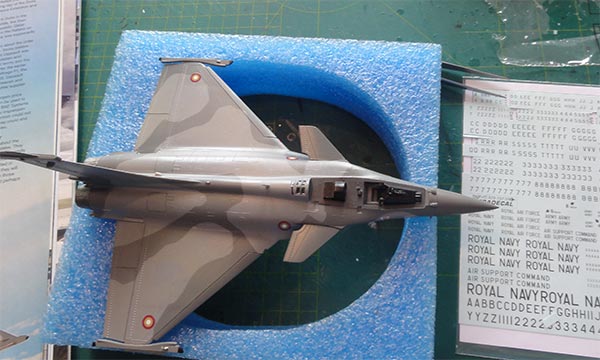
The smaller details were now handled such as the various smaller antennas. On the vertical tail, the 2 side VOR antennas in front of the rudder are correct. The large ECM and RWR tail fairing is also nicely done and also has the small rear position tail light. But I now found that the round antenna on top of the tail is not applicable for a land based Rafale (like the C). This "naval landing aid" was cut off.
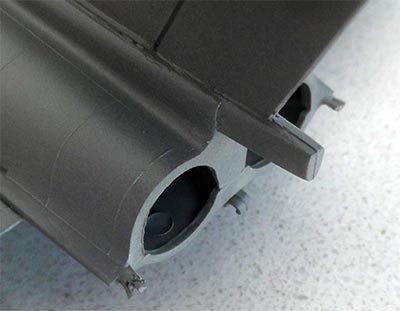 ......
......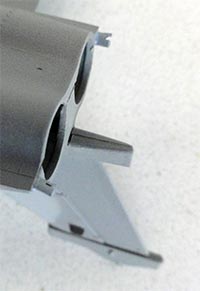
At the end the Rafale -C F3 has 2 tiny probable chaff/decoy launchers next to the jet exhausts. The later batch Qatar Rafale -C F3 have these, so these were added from scrap. Also 2x2 Air flow vanes were added at the lower nose.
The land-based arrestor hook with smaller made attachment fairing was added from a piece of rod and painted aluminium.
Detail painting was now done, such as the lighter grey insides of gear doors and the undercarriage struts and wheel hubs aluminium. Just like the Aeronavale -M the area aft of the APU exhaust part #A16 was painted metal and the smaller vertical black cooler grills seen in that area suggested with a very tiny permanent marker.
But the very tiny raised panels on the curved nose side are missing; these were made from a piece of card op 0,5 x 0,5mm. The smaller flat areas on the canard fairings for the SPECTRA system painted darker grey like the small added nose panels.
The cockpit got a few details added like the "wide angle" HUD from clear plastic sheet and part #A3 for the license made Martin Baker Mk.16 SEMMB seat got some straps.
It was decided to set the canopy closed. With windshield and canopy set, any small tiny gaps were filled with white glue with a tooth pick. When dried, painted the seals with the grey mix with a fine brush.
A pair of MICA missiles were painted white (on many other Rafales these are ghost grey), decals from kit added. The ridges on the outsides of the wing pylons were cut off and missiles set. The outher 2 wing fuel tanks got their holes enlarged in order to fit.
Finally the model got a gloss varnish coat using a mix of Johnson Future / Pledge floor care thinned with 30% IPA alkohol. (shield off the clear cockpit while varnish airbrushing).
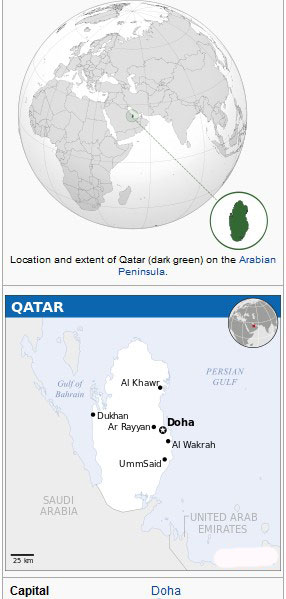

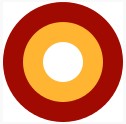
[ area: 11,580 sq.km | capital: Doha | population 2,6 million | nom GDP 68,000 UDS per capita ]
Before the 1970s there was a British military presence in the Gulf. In 1968 for the Gulf States including Qatar a security force was set up with a few Whirlwind helicopters and in 1971 a few ex-RAF Hawker Hunters arrived. The Emir declared independence in September 1971.
The Qatar Emiri Air Force was established in 1974. Other types were a few B727 and B707 jets and BN Islanders. Some Gazelle and Seaking helicopters were also delivered. In the 1980s followed 6 Alpha jets for training and light ground attack and a dozen Mirage F-1 fighters. From 1990 some 12 Mirage 2000 jets were acquired. During the first Gulf War in 1991 Qatar supported the Western armed forces against Iraq. Near Doha a new air base was established, Al Udaid.
In 2019 the first Rafale was delivered to Qatar. Initially in 2015 a contract for 24 aircraft was agreed but end 2017 an additional 12 were ordered, so total of 36 Rafale EQ/DQ. Most fly from the new Tamim air base with the "Al Adiyat" squadron.
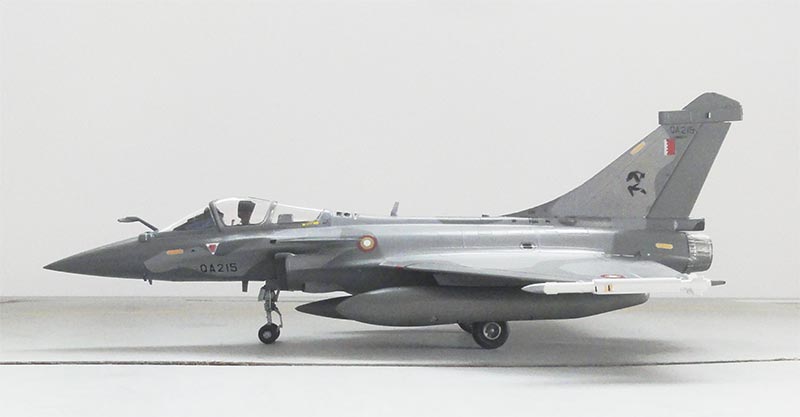

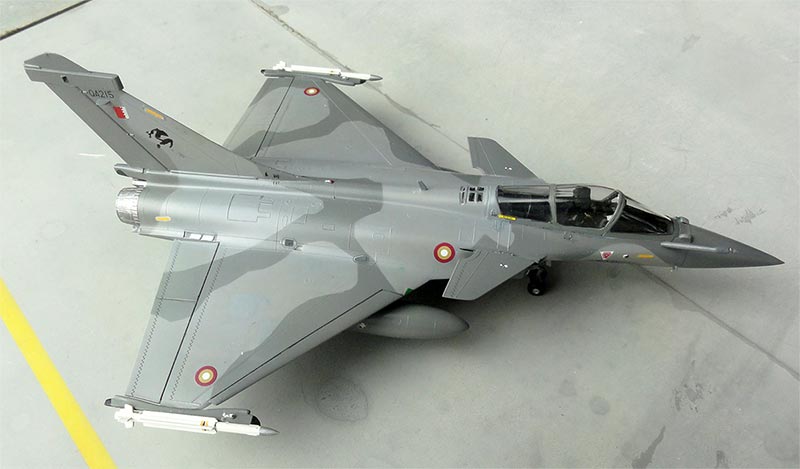
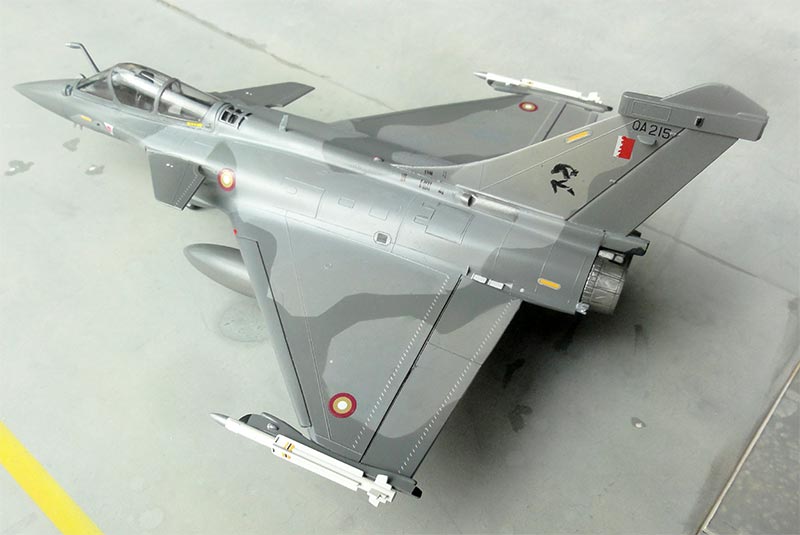
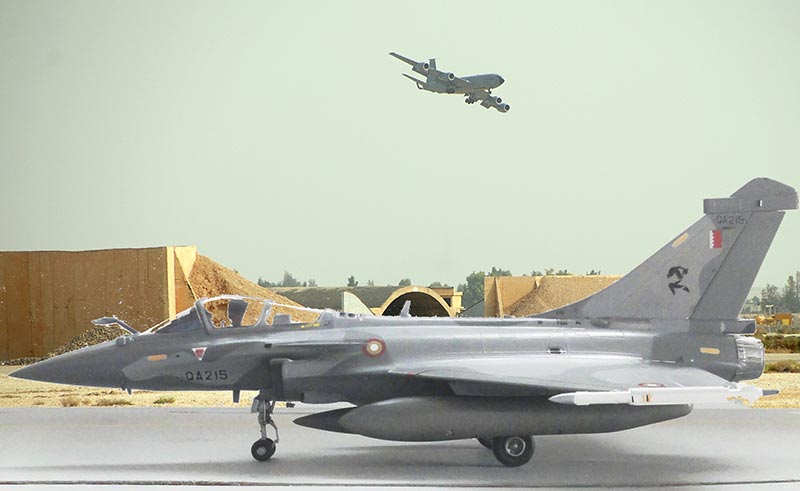
- Air international, vol 52, page 350-355;
- Air international, vol 42, page 233-240;
- Flight international, magazine no. 4168
Net:
- my walk around on the IPMS.NL website...

(c) Copyright Meindert "designer"/ All rights reserved. Your comments are welcomed by webmaster
Created this page
Sept 10, 2021